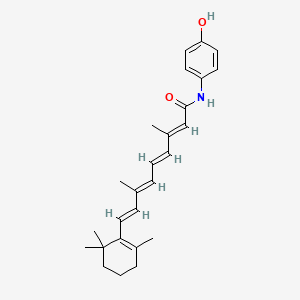



1. 13-cis-isomer Fenretinide
2. 4 Hydroxyphenylretinamide
3. 4-hpr
4. 4-hydroxyphenylretinamide
5. Fenretinide, 13 Cis Isomer
6. Fenretinide, 13-cis-isomer
7. Fenretinimide
8. Mcn R 1967
9. Mcn-r-1967
10. Mcnr1967
11. N-(4-hydroxyphenyl)-trans-retinamide
12. N-(4-hydroxyphenyl)retinamide
1. 65646-68-6
2. N-(4-hydroxyphenyl)retinamide
3. 4-hpr
4. 4-hydroxyphenylretinamide
5. 4-hydroxyphenyl Retinamide
6. Retinoic Acid P-hydroxyanilide
7. All-trans-4'-hydroxyretinanilide
8. Mcn-r-1967
9. Fenretinida
10. Fenretinidum
11. 4-hydroxy(phenyl)retinamide
12. N-(4-hydroxyphenyl)all-trans Retinamide
13. Retinamide, N-(4-hydroxyphenyl)-
14. Rii Retinamide
15. Retinoic Acid P-hydroxyphenylamide
16. 4-(hydroxyphenyl)retinamide
17. 15-[(4-hydroxyphenyl)amino]retinal
18. (2e,4e,6e,8e)-n-(4-hydroxyphenyl)-3,7-dimethyl-9-(2,6,6-trimethylcyclohex-1-en-1-yl)nona-2,4,6,8-tetraenamide
19. Nsc-760419
20. 187ej7qexl
21. Chembl7301
22. Mls002701698
23. Chebi:42588
24. Nsc-374551
25. Ncgc00090752-03
26. Dsstox_cid_12005
27. Dsstox_rid_78900
28. Dsstox_gsid_32005
29. Fenretinidum [latin]
30. Fenretinida [spanish]
31. 4hpr
32. Fenretinide [usan:inn]
33. Smr001456303
34. Cas-65646-68-6
35. Ccris 3260
36. Sr-01000075917
37. (2e,4e,6e,8e)-n-(4-hydroxyphenyl)-3,7-dimethyl-9-(2,6,6-trimethylcyclohexen-1-yl)nona-2,4,6,8-tetraenamide
38. Mfcd00792674
39. Unii-187ej7qexl
40. Brn 5769490
41. Syt-101
42. St-602
43. Fenretinide; 4-hpr
44. Fenretinide (4-hpr)
45. P-hydroxyphenylretinamide
46. Fenretinide [mi]
47. Spectrum5_001939
48. Fenretinide [inn]
49. Fenretinide (usan/inn)
50. Fenretinide [usan]
51. Fenretinide [vandf]
52. Fenretinide [mart.]
53. Lopac0_000625
54. Schembl11703
55. Schembl11704
56. Bspbio_001419
57. Fenretinide [who-dd]
58. Mls001055399
59. Mls006010811
60. Bml2-e08
61. N-(4-hydroxyphenyl)-retinamide
62. Dtxsid2032005
63. Schembl15703189
64. Chebi:92493
65. Amy9087
66. 15-(4-hydroxyanilino)retinal #
67. Hms1361g21
68. Hms1791g21
69. Hms1989g21
70. Hms2089b17
71. Hms3261n12
72. Hms3402g21
73. Hms3412m06
74. Hms3676m06
75. Pharmakon1600-01505602
76. 4-hpr;(4-hydroxyphenyl)retinamide
77. Bcp06908
78. Ex-a4102
79. N-(4-hydroxyphenyl)-3,7-dimethyl-9-(2,6,6-trimethyl-1-cyclohexenyl)nona-2,4,6,8-tetraenamide
80. Zinc3871023
81. Tox21_111007
82. Tox21_200989
83. Tox21_500625
84. 1-enyl)nona-2,4,6,8-tetraenamide
85. Bdbm50092055
86. Hsci1_000112
87. Nsc374551
88. Nsc760419
89. S5233
90. Calix[4!-bis-crown-6,95
91. Akos024456572
92. Tox21_111007_1
93. Ccg-204713
94. Cs-0789
95. Db05076
96. Lp00625
97. Mk-4016
98. N-(4-hydroxyphenyl)retinamide, 4-hpr
99. Nsc 760419
100. Sdccgsbi-0050606.p002
101. All-trans-n-(4-hydroxyphenyl)retinamide
102. Dimethyl-9-(2,6,6-trimethylcyclohex-
103. Idi1_033889
104. Retinoic Acid P-hydroxyanilide, >=95%
105. Ncgc00090752-01
106. Ncgc00090752-02
107. Ncgc00090752-04
108. Ncgc00090752-05
109. Ncgc00090752-06
110. Ncgc00090752-07
111. Ncgc00090752-09
112. Ncgc00090752-10
113. Ncgc00090752-11
114. Ncgc00090752-12
115. Ncgc00090752-20
116. Ncgc00258542-01
117. Ncgc00261310-01
118. As-59667
119. Bp-13369
120. Hy-15373
121. Smr000677938
122. Eu-0100625
123. H1464
124. D04162
125. H 7779
126. (2e,4e,6e,8e)-n-(4-hydroxyphenyl)-3,7-
127. Ab00172992-07
128. 646f686
129. A835178
130. Q5443576
131. Sr-01000075917-1
132. Sr-01000075917-4
133. N-(4-hydroxyphenyl)-all-trans-vitamin A Amide
134. (2e,4e,6e,8e)-3,7-dimethyl-9-(2,6,6-trimethyl-cyclohex-1-enyl)-nona-2,4,6,8-tetraenoic Acid (4-hydroxy-phenyl)-amide
135. (2e,4e,6e,8e)-n-(4-hydroxyphenyl)-3,7-dimethyl-9-(2,6,6-trimethyl-1-cyclohexenyl)nona-2,4,6,8-tetraenamide
136. (2e,4e,6e,8e)-n-(4-hydroxyphenyl)-3,7-dimethyl-9-(2,6,6-trimethylcyclohex-1-enyl)nona-2,4,6,8-tetraenamide
137. (2e,4e,6e,8e)-n-(4-hydroxyphenyl)-3,7-dimethyl-9-(2,6,6-trimethylcyclohexen-1-yl)nona-2,4,6,8-tetraenamide;fenretinide
138. 2,6,8-nonatetraenamide, N-(4-hydroxyphenyl)-3,7-dimethyl-9-(2,6,6-trimethyl-1-cyclohexen-1-yl-, (all-e)-
139. 3,7-dimethyl-9-(2,6,6-trimethyl-cyclohex-1-enyl)-nona-2,4,6,8-tetraenoic Acid (4-hydroxy-phenyl)-amide
140. N-(4-hydroxyphenyl)-3,7-dimethyl-9-(2,6,6-trimethyl-1-cyclohexenyl)-2,4,6,8-nonatetraeneamide
| Molecular Weight | 391.5 g/mol |
|---|---|
| Molecular Formula | C26H33NO2 |
| XLogP3 | 7.3 |
| Hydrogen Bond Donor Count | 2 |
| Hydrogen Bond Acceptor Count | 2 |
| Rotatable Bond Count | 6 |
| Exact Mass | 391.251129295 g/mol |
| Monoisotopic Mass | 391.251129295 g/mol |
| Topological Polar Surface Area | 49.3 Ų |
| Heavy Atom Count | 29 |
| Formal Charge | 0 |
| Complexity | 726 |
| Isotope Atom Count | 0 |
| Defined Atom Stereocenter Count | 0 |
| Undefined Atom Stereocenter Count | 0 |
| Defined Bond Stereocenter Count | 4 |
| Undefined Bond Stereocenter Count | 0 |
| Covalently Bonded Unit Count | 1 |
Investigated for use/treatment in macular degeneration.
Anticarcinogenic Agents
Agents that reduce the frequency or rate of spontaneous or induced tumors independently of the mechanism involved. (See all compounds classified as Anticarcinogenic Agents.)
Antineoplastic Agents
Substances that inhibit or prevent the proliferation of NEOPLASMS. (See all compounds classified as Antineoplastic Agents.)
Fenretinide has known human metabolites that include (2S,3S,4S,5R)-6-[4-[[(2E,4E,6E,8E)-3,7-dimethyl-9-(2,6,6-trimethylcyclohexen-1-yl)nona-2,4,6,8-tetraenoyl]amino]phenoxy]-3,4,5-trihydroxyoxane-2-carboxylic acid.
S73 | METXBIODB | Metabolite Reaction Database from BioTransformer | DOI:10.5281/zenodo.4056560
Fenretinide inhibits the growth of several human cancer cell lines, acting through both retinoid-receptor-dependent and retinoid-receptor-independent mechanisms.1In vivo, fenretinide selectively accumulates in breast tissue and is particularly active in inhibiting rat mammary carcinogenesis.1 An important feature of fenretinide is its ability to inhibit cell growth through the induction of apoptosis rather than through differentiation, an effect that is strikingly different from that of vitamin A.1 In contrast to tamoxifen, which inhibits only estrogen receptor (ER)-positive tumors, fenretinide induces apoptosis in both ER-positive and ER-negative breast cancer cell lines.2 All of these properties render fenretinide an attractive candidate for breast cancer chemoprevention.